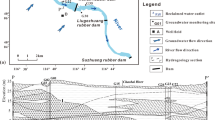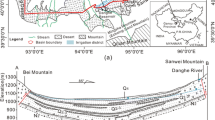Abstract
Artificial recharge is an effective way to alleviate water shortages and excessive groundwater exploitation. In this study, to explore environmental changes of surface water and groundwater during multi-water-sources recharge process, numerical simulation method was applied. Local reclaimed water, treated by wetland, and water from the South-to-North Water Transfer Project (SNWTP) were used to recharge groundwater reservoir in Mi-Huai-Shun District (Miyun District, Huairou District and Shunyi District). The Flow Model results showed that the accumulated loss of the groundwater resource in the Mi-Huai-Shun area from 2007 to 2016 reached – 1.784 × 109 m3. All the water sources contribute to the recharge of groundwater, raising the groundwater level and increasing the groundwater reserves. Meanwhile, the Solute Transport Model results show that different water source has different effects on the local groundwater environment. chloride concentration of reclaimed water source and wetland water source are higher than groundwater, and the artificial recharge caused the chloride concentration of groundwater in receiving area to rise. The water from the SNWTP played an important role on reducing chloride concentration due to dilution. In addition, Multi-Water-Source artificial recharge is also related to the local hydrogeological conditions. This study provides a comprehensive analysis of the impact of multi-water-source recharge on groundwater quantity and quality.





Similar content being viewed by others
REFERENCES
Asano, T. and Cotruvo, J.A., Groundwater recharge with reclaimed municipal wastewater: health and regulatory considerations, Water Res., 2004, vol. 38, no. 8, pp. 1941–1951.
Asano, T., Groundwater recharge with reclaimed municipal wastewater, Migration and Fate of Pollutants in Soils and Subsoils, Berlin: Springer, 1993, pp. 413–434.
Bouwer, H., Artificial recharge of groundwater: hydrogeology and engineering, Hydrogeol. J., 2002, vol. 10, no. 1, pp. 121–142.
Buxton, H.T., Kolpin, D.W., Furlong, E.T., Meyer, M.T., Thurman, E.M., Zaugg, S.D., and Barber, L.B., Pharmaceuticals, hormones, and other organic wastewater contaminants in U.S. streams, 1999–2000: a national reconnaissance, Environ. Sci. Technol., 2005, pp. 1202–1211.
Diersch, H.-J.G., FEFLOW: finite element subsurface flow and transport simulation system. Reference manual, Berlin: WASY, 2009.
Diersch, H.-J.G., FEFLOW: user’s manual. Institute for Water Resources Planning and Systems, Berlin: WASY, 1998.
Diersch, H.-J.G., Reference manual FEFLOW. Institute for Water Resources Planning and Systems Research, Berlin: WASY, 1998.
Eusuff, M.M. and Lansey, K.E., Optimal operation of artificial groundwater recharge systems considering water quality transformations, Water Resour. Manag., 2004, vol. 18, no. 4, pp. 379–405.
Goren, O., Gavrieli, I., Burg, A., and Lazar, B., Cation exchange and CaCO3 dissolution during artificial recharge of effluent to a calcareous sandstone aquifer, J. Hydrol., 2011, vol. 400, nos. 1–2, pp. 165–175.
Hoffmann, A. and Gunkel, G., Bank filtration in the sandy littoral zone of Lake Tegel (Berlin): structure and dynamics of the biological active filter zone and clogging processes, Limnologica–Ecol. Manag. Inland Waters, 2011, vol. 41, no. 1, pp. 10–19.
Kinney, C.A., Furlong, E.T., Werner, S.L., and Cahill, J.D., Presence and distribution of wastewater-derived pharmaceuticals in soil irrigated with reclaimed water, Environ. Toxicol. Chem. 2006, vol. 25, pp. 317–326.
Li, F.C., The research of the construction condition analysis of Mi Huai Shun underground reservoir, Tsinghua univ., 2015.
Li, S., Li, J. and Zhang, Q., Water quality assessment in the rivers along the water conveyance system of the middle route of the south to north water transfer project (China) using multivariate statistical techniques and receptor modeling, J. Hazard. Mater., 2011, vol. 195, no. 1, pp. 306–317.
Li, Z., Xu, C., Li, M., Yan, G., Liu, X., and Ma, Y., Identification and assessment of water safety risk for groundwater recharge with reclaimed water in china, Stoch. Environ. Res. Risk Assess., 2016, pp. 1–12.
Liang, J., Zheng, F.D., Liu, L.C., and Li, B.H., Study on necessity and key problems of groundwater recharge with reclaimed water in Beijing, Beijing water, 2011, vol. 1, pp. 26–28.
Liu, C.M., Exploring an ecological benefit of south-to-north water transfers for rehabilitating groundwater systems in the North China Plain, South to North Water Transfer and water conservancy science and technol., 2003, vol. 1, no. 1, pp. 000017–19.
Ma, D.C. and Zhao, Q., National Bureau of Statistics, Beijing Water Statistical Yearbook, Beijing, Beijing water Authority.
Maeng, S.K., Sharma, S.K., Kerteunissen, K., and Amy, G.L., Occurrence and fate of bulk organic matter and pharmaceutically active compounds in managed aquifer recharge: a review, Water Res., 2011, vol. 45, no. 10, pp. 3015–33.
Massmann, G., Greskowiak, J., Dünnbier, U., Zuehlke, S., Knappe, A., and Pekdeger, A., The impact of variable temperatures on the redox conditions and the behaviour of pharmaceutical residues during artificial recharge, J. Hydrol., 2006, vol. 328, no. 1, pp. 141–156.
Moeck, C., Radny, D., Auckenthaler, A., Brennwald, M., Hollender, J., and Schirmer, M., Estimating the spatial distribution of artificial groundwater recharge using multiple tracers, Isot. Environ. Health Stud., 2017, pp. 484–499.
Moeck, C., Radny, D., Popp, A., Brennwald, M., Stoll, S., Auckenthaler, A., Berg, M., and Schirmer, M., Characterization of a managed aquifer recharge system using multiple tracers, Sci. Total Environ., 2017, vol. 609, pp. 701–704.
Scanlon, B.R., Keese, K.E., Flint, A.L., Flint, L.E., Gaye, C.B., and Edmunds, W.M., Global synthesis of groundwater recharge in semiarid and arid regions, Hydrol. Processes, 2006, vol. 20, no. 15, pp. 3335–3370.
Schmidt, C.M., Fisher, A.T., Racz, A.J., Lockwood, B.S., and Huertos, M.L., Linking denitrification and infiltration rates during managed groundwater recharge, Environ. Sci. Technol., 2011, vol. 45, no. 22, p. 9634.
Tian, Y., Lei, X.H., Sun, J.L., and Jiang, Y.Z., The situation and countermeasures of water resources in Beijing before the south to North Water Diversion Project, South to North Water Diversion and Water Conservancy Sci.Technol., 2011, vol. 09, no. 2, pp. 60–63.
Vandenbohede, A. and Houtte, E.V., Heat transport and temperature distribution during managed artificial recharge with surface ponds, J. Hydrol., 2012, vols. 472–473, no. 4, pp. 77–89.
Wei, S., Yang, H., Abbaspour, K., Mousavi, J., and Gnauck, A., Game theory based models to analyze water conflicts in the middle route of the south-to-north water transfer project in China, Water Res., 2010, vol. 44, no. 8, pp. 2499–516.
ACKNOWLEDGMENTS
Partial support for this study came from the National Key Research and Development Program (2016YFC0401404) and the Beijing Municipal Science and Technology Commission Project (K2004018201601). Special thanks are given to teacher Wu Jin and Huang Xuezheng and student GuoWenjun.
Author information
Authors and Affiliations
Corresponding authors
Rights and permissions
About this article
Cite this article
Dasheng Zhang, Zhang, Y., Liu, L. et al. Numerical Simulation of Multi-Water-Source Artificial Recharge of Aquifer: A Case Study of the Mi-Huai-Shun Groundwater Reservoir. Water Resour 47, 399–408 (2020). https://doi.org/10.1134/S0097807820030057
Received:
Revised:
Accepted:
Published:
Issue Date:
DOI: https://doi.org/10.1134/S0097807820030057




